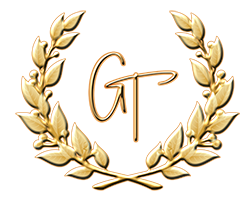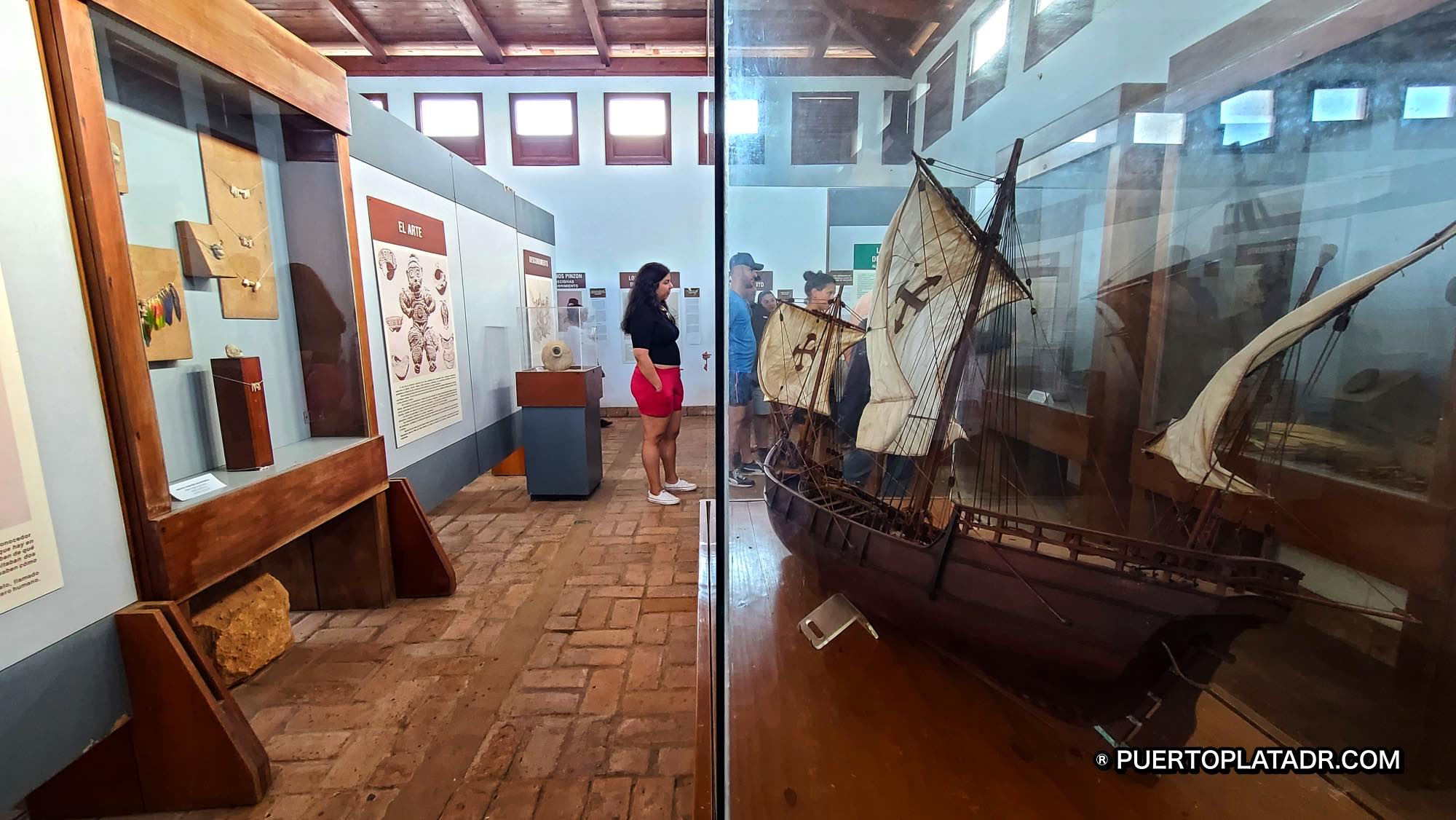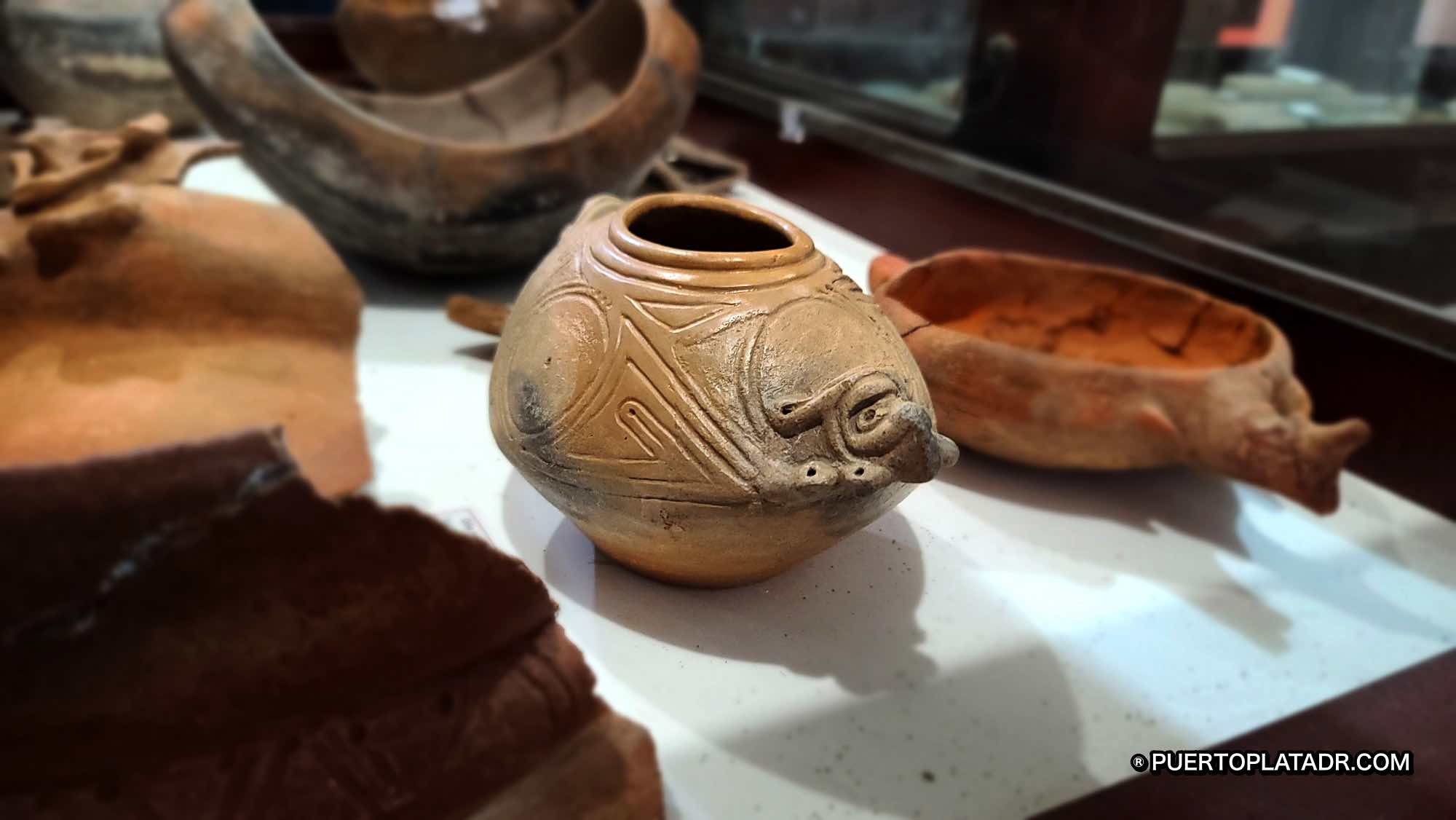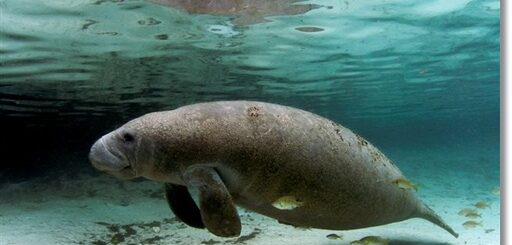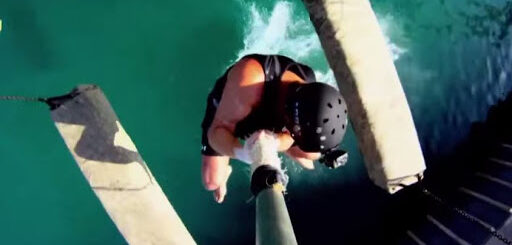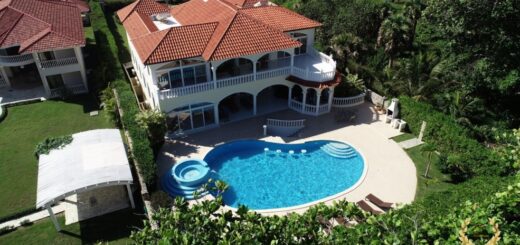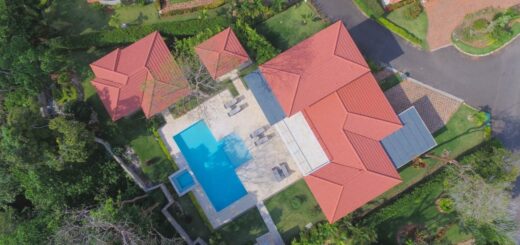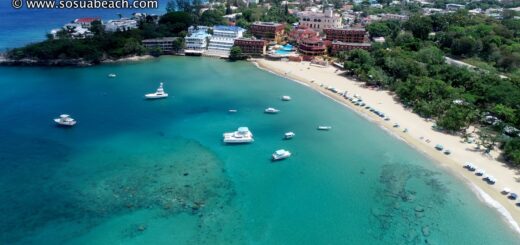The Taino in Dominican Republic
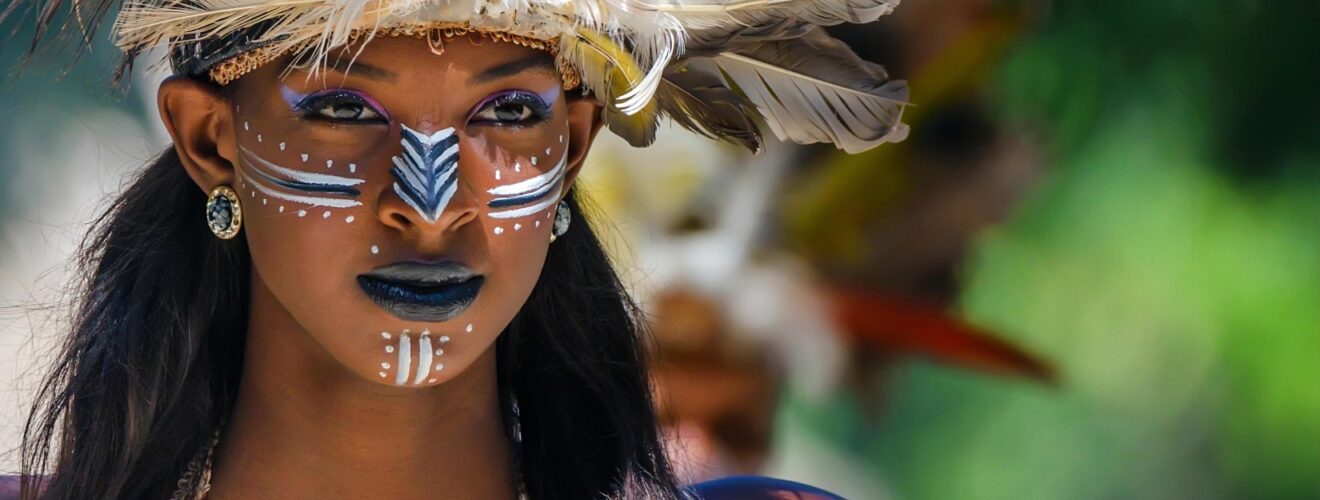
(Updated November 20th, 2023). The Taino, first original settlers of Hispaniola Island, now Dominican Republic. When Christopher Columbus found the American continent back in October 12, 1492 he was under the impression of being at or close to India, in his quest for a quicker trade route. What he found were the Taino, an indigenous culture that populated many of the Caribbean islands. Columbus anchored in La Isabela, Puerto Plata and built the first Spanish settlement in the New World. A local tour of La Isabela, Puerto Plata is available to visit the remains of the old city, also a museum with antique pieces.
Throughout the years to follow, the Taino were killed by the conquerors either by disease or battle, and their culture was almost completely wiped out. Most Dominicans nowadays rarely resemble what the Taino looked like, and only a few families have some Taino blood in their generations. Preserved in time, still many artifacts and stone pottery can be found in the island, and their simple art they left behind in caves. The Dominican Republic Taino were the most peaceful of these indigenous groups.
GALLERY OF TAINO LIFE IN DOMINICAN REPUBLIC
The Taino developed a culture based primarily on agricultural production that allowed them to craft a significant increase of utilitarian objects such as vases and other containers made of clay and wood, well-polished stone axes, objects of basketry and woven plant fibers cotton which were decorated with dyes extracted from the Jagua (Genipa Americana) and annatto (Bixa orellana), with which they also painted their bodies on special occasions. In addition, the Taino were excellent sculptors who drew up ceremonial artifacts of great artistic expression as duhos or ceremonial seats, idols or cemíes, instruments for the cohoba ritual and monolithic rings.
Taino Zemi – The Religious icons
The zemi (also Cemí or Zemí), whose figure, carved in various materials and sizes, could act at will to decisively influence the normal development of human life and the environment: could cohabit with men and even breed through them. The zemi was the living body of God, the mythical entity, the deified ancestor. The emotional effect that would link to the faithful and proper performance of their spiritual powers depended on the expertise to craft it and the ability to be able to reflect the nature of it.
The collection of some wild fruits, fishing and hunting supplemented the food in the Taino Village, using tools and techniques, along with the practical and medicinal use given to certain plants, showing the Taino`s deep knowledge of the natural environment.
When the Europeans arrived, the Tainos inhabited much of the Spanish islands and Puerto Rico, as well as eastern Cuba and Jamaica.

Zemies were the Taino gods to foster prosperity.
Taino society was very religious, and at the core there were the Duhos ( ceremonial seats ) and the Zemí, such as the trigonolith deity shown here.
Although somewhat short in stature, the Taino Indians had well formed bodies and coppery skin color. People were hairless, broad face, with very pronounced cheekbones, lips a little thick and very good teeth. The Tainos were always naked, wearing only garters and girdles of cotton yarn in arms and legs, although some married women used some skirts, also woven in cotton.
Between them there was a custom of artificially deforming the skull of children, holding it with two tablets of cotton strips palm, one in front and one in the occipital, which managed to make the forehead look wider. They perforated the lower lobe of the ear in order to wear decorative pins or earrings, called in their language taguaguas. Atabey or Atabeyra was the supreme deity of the Taino, goddess of fresh water and fertility.
Social Life
Their social, political and religious organization was the most developed among indigenous groups in the West Indies. Their maximum territorial unit was the “chiefdom” which grouped certain villages or “yucayeques”, which were run by caciques, amounting to these positions by the matrilineal inheritance or making something extraordinary.
The chief was distinguished by the guanine or gold disc hanging on his chest, and the use of belts made of cotton braided with rhinestone beads and shells, as well as ribbons worn in the head, inserted with a guaiza or small central dial.
When the boss was out for a journey far from the village, his subjects would carry him on a litter of wood and straw, while his children would follow carried on the shoulders.
The chiefs were assisted by high-ranking characters, called nitaínos, naborias being of lower social level, on who fell agricultural work and other work and services.
The behique or witch doctor of the tribe was another character of importance in Taino society, having a vast knowledge of the primitive pharmacopoeia and ensure the healing of the sick by magic-medicinal practices, speaking also in the preparation of the cohoba idols, and other ritual objects.
Productive activities
The Tainos called conuco the area where they farmed crops, and used farming techniques using mounds and planting in the slash to later burn the cropping area. In the mounds or piles, consisting of circular mounds of loose soil, thrived tuberous roots such as cassava (Manihot esculenta) , yams and sweet potatoes (Ipomoea batatas), while the slash was used primarily for planting of maize (corn), which was planted in full moon time believing that it ensures the growth of the plant.
The Tainos also took advantage of the rain cycles to kick off their crops and in the final stage of their development and used certain types of irrigation ditches where needed due to the dryness of the land. With the friction of the wood Taino got fire to use it in the cooking of their food, to baked pottery and also knocked down large trees to prepare their crops or conucos and make canoes.
When they were walking or fishing at night they did it with lighted torches of resinous wood or pieces as Cuaba or pine (Pinus occidentalis) and goaconax or guaconejo (Amiris spp.) The stone axes, scrapers like the shell, were working devices frequently used by the Amerindians, mainly to make many wooden objects.
The most typical axes in the Taino culture are petaloid, the name given to resemble flower petals, but there were other types of axes, such as the neck axes and chisels, and some of them in the hand, while most size is tied to the end of a wooden mallet.
The main crop of the Tainos was cassava (Manihot esculenta) grating or “cool” getting a mass of which elaborated the cazabí or cassava (currently, cassava), a species of dry bread or cake, previously toasted in a buren and constituted their staple food. Maize (Zea mays) was another important ingredient in his client. We harvested twice a year and ate it raw, when tender, and grilled, when more dry or mature. Also shredded or crushed to make a porridge with water.
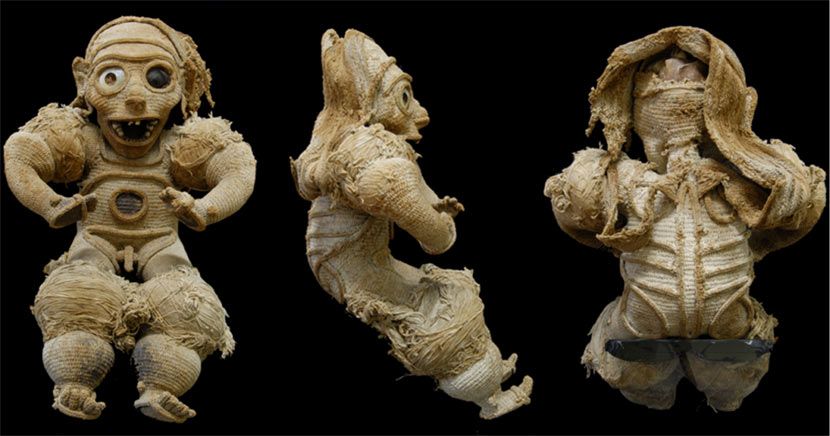
This cotton Zemi is the rarest ever found.
Hunting
For hunting birds and other animals, such as ischemia, guinea pig, hutias, iguanas, alligators, etc. they used the bow and arrow, in the use of which the Indians were very clever, besides the lancets with propellants and many forms of traps. In the case of hutias and other rodents, they used to burn the pastures, rounding up the animals to hunt in a place or simply pick them up after the fire burned.
Fishing
Fishing was a common practice of the Tainos, the reason why their villages were formed mainly by the sea and rivers and estuaries where mangroves were abundant. This activity, in addition to its diet, was done with bows and arrows, hooks made of bone or tortoise shell, and large networks of cotton dipped with stone weight.
Housing
Taino villages were called yucayeques and housing units were the huts and log cabins, made of wooden posts buried in the soil and cane reeds with roofs held down by palm leaves or straw, leaving a vent on top covered by a stand for the exhaust and smoke from the embers that always kept indoors. A single hut could accommodate several families, as was common among the married daughters of Tainos to live in the homes of their parents.
The “huts”, also called eracras were circular and conical roofs, while the “Caney”, name given to the house of chiefs, was occasionally rectangular and slightly more spacious, with gabled roof and a canopy front den, while facing the sugar mill or place where members gathered to celebrate many of its social and ceremonial activities of the tribe.
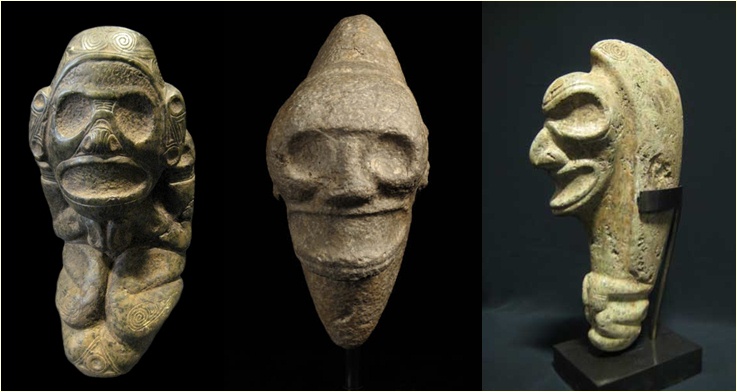
Various Dominican Republic Taino Zemis in stone shown here from a private collection show some of the best pieces in foreign hands.
Taino Art
The art of the Taino, while conceptual and utilitarian reflected first of all, its magic-religious vision of the world. Their artwork is represented by a wide range of personal items and household, and in particular, for a rich ceremonial repertoire. The variety and quantity of these objects, painstakingly drawn (remember that they had no metal tools) in different materials obtainable in your environment or derived from their trade, are more reliable sample of his innate artistic inclination.
Taino art achieves its most beautiful expressions in the middle plastic sculpture. In order to achieve his artistic goal, the Tainos used the hard stones like granite, diorite, basalt and other easier to carve than marble and serpentine. In many cases the color of the stone, the veins of the same and the polish that could give facilitated and enriched the artistic work.
They also made use of fine hardwoods as guayacán (Guaiacum officinale), mahogany (Swietenia mahagoni) and others. The bones of the manatee, the largest mammal in the West Indies, provided them with material for some of the most beautiful artifacts for ceremonial use and for carving figurines.
Human bone, particularly the femur and skull also offered the opportunity to record anthropomorphic representations of magical-religious and ceremonial ornaments. Among the most prominent of Taino art are those for cemíes worship as idols carved in wood and stone and artifacts for the cohoba rituals, along with certain musical instruments such as maracas monóxilas (single piece of wood) .
Taino Tour in Dominican Republic:
A comprehensive tour of Taino life can be taken by visiting La Isabela, the Cesar Estrella Taino Museum and the Caves of El Choco in Cabarete, Puerto Plata. These are key locations where you can have a direct experience with historic pieces, information and a true connection to their culture. There are caves with underground fresh water pools, and we (yes, editor) found one with petroglyphs dating back 800 years. It is a truly enlightening experience, recommended for those who like walking in forests land.
Taino mythology and religion
The Tainos believed in a Supreme Being whom they called Yucahu Protector Maócoti Bagua, whose mother was Atabey, Mother of Waters and Protection of the labor, but in their mythological beliefs or other deities conceived cemíes living in the sky, named Turey, relating them to the weather, the creation of the earth and mankind. Among the most accepted cemíes were the stones of three points “or trigonolitos, propitiatory rituals related to fertility, such as swidden productivity and reproduction of the human race.
The trigonolito is a highly specialized piece about the area in which it is found far more frequently. The east coast of the Spanish and the west coast of Puerto Rico have been the places where significant amounts have been found in these parts.
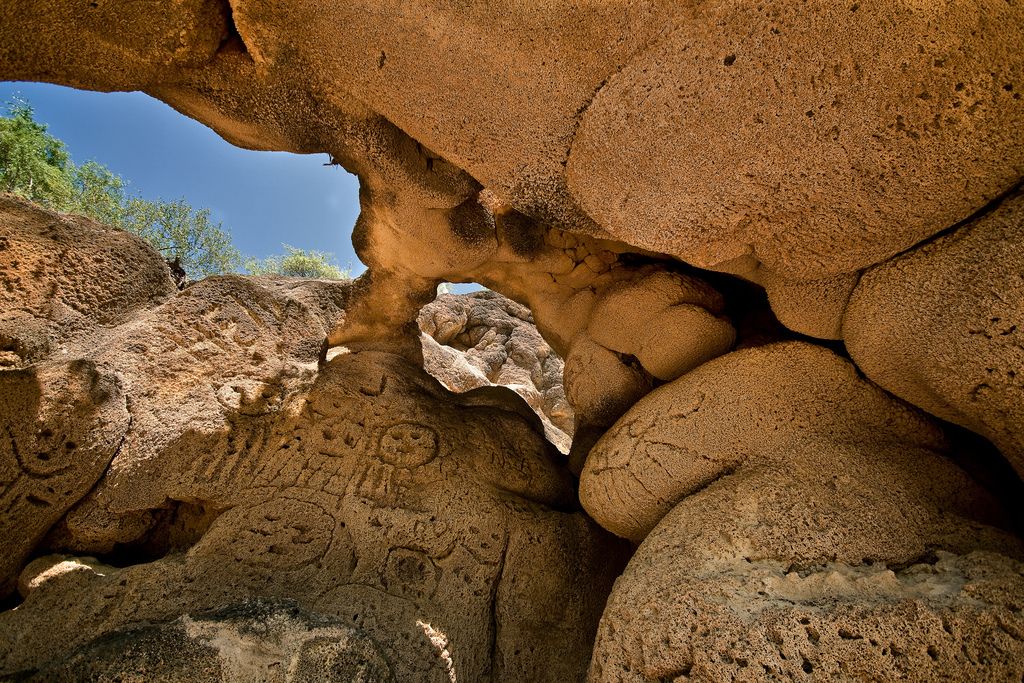
These Taino faces are found in Barahona, Dominican Republic.
The ritual of Cohoba
Among the Tainos, the main religious ceremony was the cohoba in which, by inhaling a powder hallucinogens, or behique chief went into a trance thinking to communicate with their gods or spirits to which he pleaded for help and protection. Before entering the temple the Tainos was introduced into the mouth a spatula in order to vomit, purified internally, to avoid the effects of indigestion that could produce toxic elements contained cohoba powders.
The hallucinogenic powder used in the cohoba was placed on an offering plate that usually had idols carved on the head (the cohoba cemíes, as shown above), where the priests were inhaling it through a Y-shaped canes Participants in this ceremony the body was decorated for the occasion and, upon entering the recent, were received by the chief, who played mayohabao or wooden drum, then sitting around cemí squatting before which practiced ritual. Presiding over this ceremony cohoba, like ball games and other festivities, the chiefs, together with the other lords, used to sit in a few benches, made of wood or stone, called duhos.
The Areíto
An important ritual for the Taino was the areito, which was a musical expression of song and dance, complete with recitations of facts and feats occurred in ancestral times. The areito is considered the ultimate sign within all cultural expressions of the Taíno. Usually they practiced in ceremonial places the Spanish called “pens” and was led by one main person.
The areito served to express tribal unity and educate young people and children in family traditions and society. They had very different meanings, so an areito could be loving, suffering, war, plaintive and of mystical and religious character. In other words, the rites areitos solemnized anniversaries, weddings, ascent of chiefs, crops and military victory.
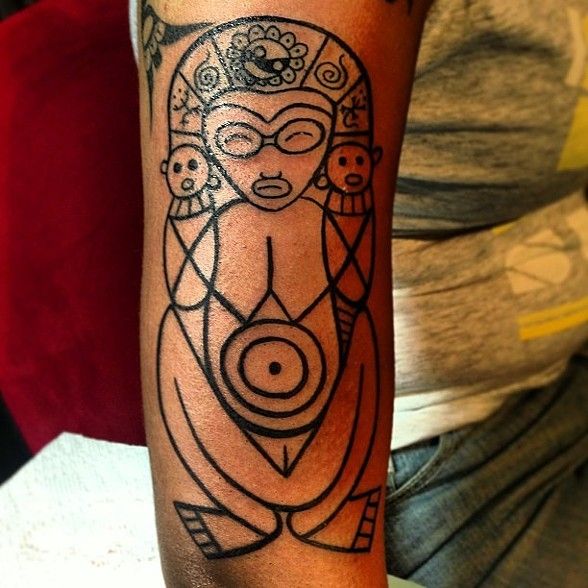
Taino goddess tattoo, Atabey
Burial practices
With regard to death, there was no ritual unit, so the funeral ceremonies were carried in different forms. The only thing that unified the rituals and ceremonies of burial was the belief in an afterlife or unearthly world, so that the dead were buried with their belongings essential to further reconcile the personal life of material life. If the person who died was a chieftain , his favorite wife would be buried alive with him, along with personal items of everyday use to ease the passage to the afterlife.
A permanent exhibition on Taino life is displayed at the Museo Del Hombre Dominicano, a national museum in Santo Domingo that holds artifacts, pottery and a scaled representation of taino life. Golden Treasures Real Estate and Vacation Rentals in Sosua is working on a project to create a Taino Museum for the North coast where tourists can learn and enjoy the ancient culture of Dominicans dating back hundreds of years.
MODERN TAINO AND CONFLICTING VIEWS
In present-day islands of Puerto Rico and the Dominican Republic, several groups are pushing to reclaim their Taino identity. An article by the National Geographic Society explores the demands of Taino groups to be recognized and acknowledged, no longer declared extinct. Several movements such as Black Lives Matter have triggered demands to remove Christopher Columbus statues ( link opens in a CBS news article ) in several cities across Latin America, citing the American continent discovery as an invasion and genocide that decimated the native Taino, and proposing a different view of Admiral Columbus, not so much as hero but more as an invader.
For places like the Dominican Republic, being the first Spanish settlement in the Americas make it very hard to deal with removing or changing the image of Columbus. The most expensive monument ever ( a cross-shaped lighthouse museum ) was built in 1992 to celebrate the 500th anniversary of the discovery of the Americas, when Columbus landed in what he later called La Isabela, in Puerto Plata ( October 12th, 1492). This historical fact has been often used as a backdrop to attract tourism to the island, which is a major income source. At least in the DR, it will be near impossible to rewrite history as proposed in other countries.
Taino, Survivors of a paper genocide: An article by National Geographic
TAINO WORDS IN USE TODAY:
Arepa (folded corn pancake), areito (traditional dance), barbacoa(bbq), batata (patata), batey (sacred place to host games and ceremonies, now sugarcane plantation town), batú (ball), borikén o Borinquén (great land, Puerto Rico), bohío (thatched hut), boricua (Puerto Rican), cabuya (fine thread, used for fishing), cacike o cacique (chief), caníbal (violent aborigines), canoa (wooden kayak), carey (sea turtle), Caribe (arawak aborigienes, violent ones), cayo (waterway between islands), cayuco (wooden kayak), cemí (deity), cocuyo (firefly), cokí o coquí (tiny frog), colibrí (hummingbird), conuco (farming land), dajao (river fish), fotuto (seashell made horn), guagua (transit, walkway), guamíkéni (Lord of the water and land, how Taino called Spaniards), guazabara o guasábara (war, warrior/ also fishermen use that word when school of fish jump out of the water, big fish feeding below), Haiti (Actual Haiti), hamaca (braided cotton hammock), huracán ( hurricane), hutia (endemic local animal), iguana (lizard), inagua (enagua, a cotton made skirt for married women), jíbaro (peasant), macana (club, as in police club), manatí (Manatee, the marine species), maraca (musical instrument), piragua (extended kayak), quemí (Caribbean rabbit), sabana ( wide plains), taíno (good people, the gentle side of arawaks, peaceful), tiburon (shark) y zum-zum o zunzún (hummingbird).
Two of the most important business groups in the Dominican Republic have published comprehensive works on the life and society of Taino, highly recommended for its pictorial collection:
Taínos Arte Y Sociedad By Banco Popular is a more recent work published in August 2020, with an online discussion session ( conversatorio, in Spanish )now available on video, by José Marmol.
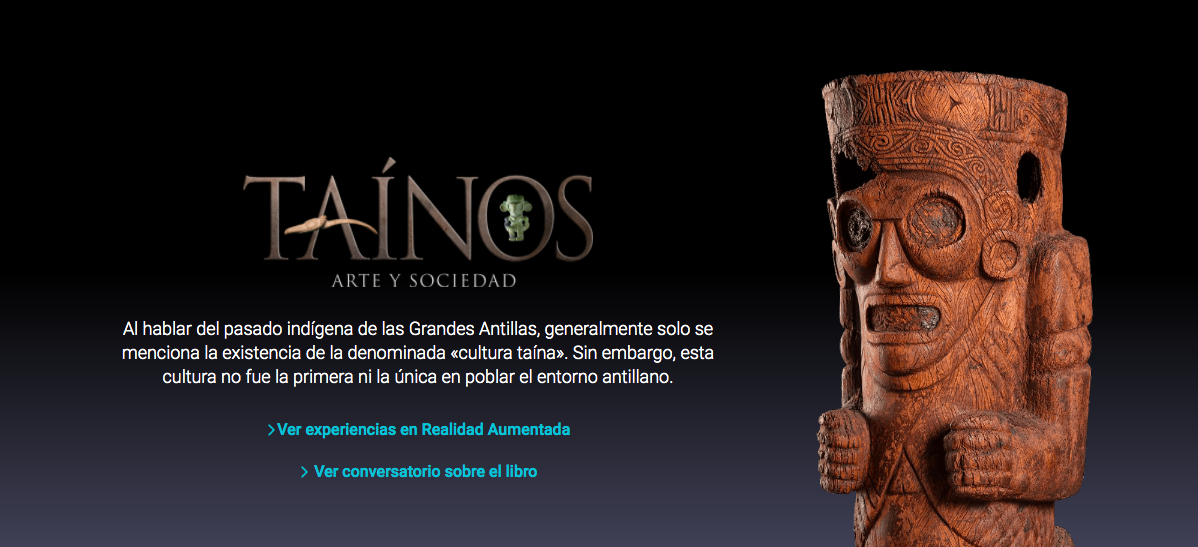
Tainos Arte y Sociedad is available to visit online as well as print. By Banco Popular in Dominican Republic.
Joyas del Arte Taino, by Vicini is one of the most important books ( also available online, ENG ) displaying a vast collection of artifacts from various periods of the Taino culture in the region. From the book prologue: “
VICINI, through the publication of “Jewels of Taino Art” who performed in December 2011, brings several private and public collections in the Dominican Republic of the outstanding pieces of the Taino culture.
These pieces of art, which in the past were artifacts of daily use of the Tainos, are now a subject of careful study at world level, which has elucidated through the features and uses of the same part of the customs and beliefs of this town.
As part of its commitment to the development of the Dominican Republic, VICINI promotes art and pre-Columbian Taino culture and part of the origins of Hispaniola and the Dominican Republic and Haiti.
This collection of photographs, based on the book ‘Jewels of Taino Art’ VICINI is done with the purpose of carrying images of this publication available to those skilled in the art and those who want to know more about the Taino people.”
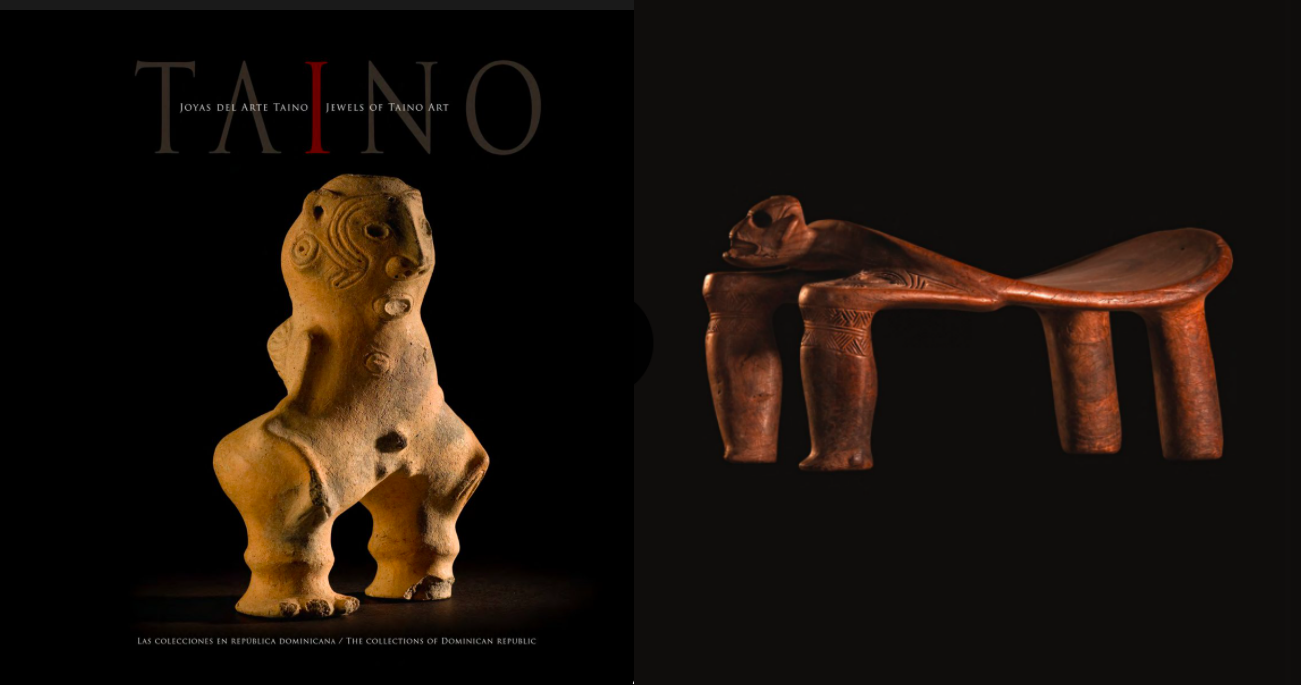
Joyas del Arte Taino, by Vicini is also an ebook with the most complete collection of Taino artifacts.
Patrimonio Nacional
A more recent work by Banco Popular, Patrimonio Nacional depicts and catalogs the most complete list of monuments, buildings, art and pieces that comprise the Dominican National Heritage. Dominican jewels of culture and nature. This editorial publication explores the treasures that make up the Dominican national heritage in all its dimensions: material, immaterial, natural and underwater. Throughout its pages, six distinguished experts in history, architecture and environmental conservation narrate the origins of our diverse heritage, awakening the reader’s interest in knowing and preserving the roots of Dominican culture.
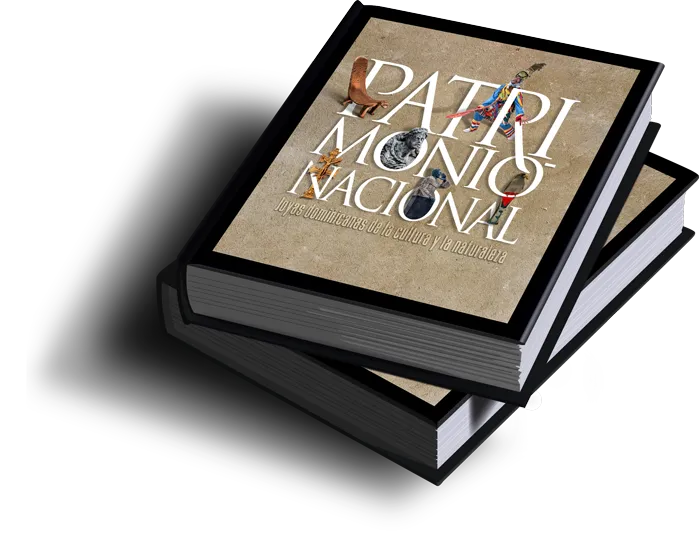
Sources of information on Tainos from the Dominican Republic:
http://anthropology.si.edu/cm/taino.htm
http://www.visiting-the-dominican-republic.com/dominican_republic_history.html
Christopher Columbus Diary ( English translation ) a must read.
Taino: Indigenous Caribbeans – Blackhistorymonth
Parque Nacional Historico La Isabela – where it all started in 1492, in Puerto Plata.
Origen de la Genetica en Republica Dominicana – Genetics of Dominican People ( SPA ), Diario Libre
The book Taino: Pre-Columbian Art and Culture from the Caribbean from Ricardo Alegria and Jose Arrom depict some of the best periods of the Taino art. Caciques and Cemí Idols By Jose Oliver is also in our recommended list, and Tainos and Caribs by Sebastian Robiou explores the culture from various perspectives.
Taino Tour in Dominican Republic
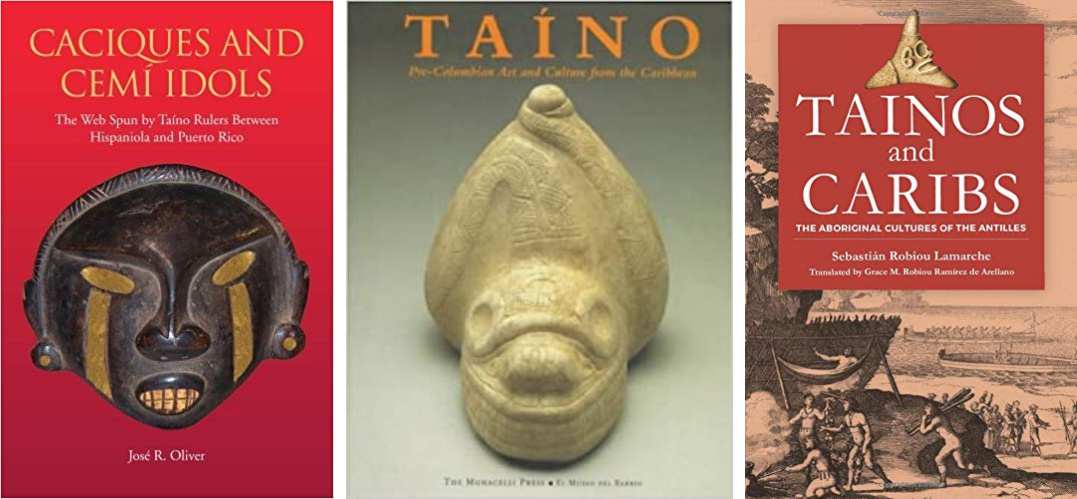
Three books we recommend on Taino History and life.
©MMXI Edward Rivas for Golden Treasures Real Estate in Dominican Republic. Updated on January 13th, 2023.
